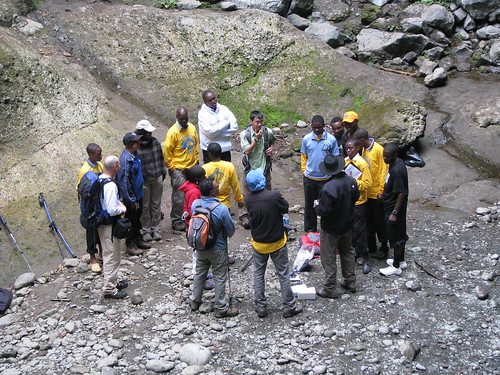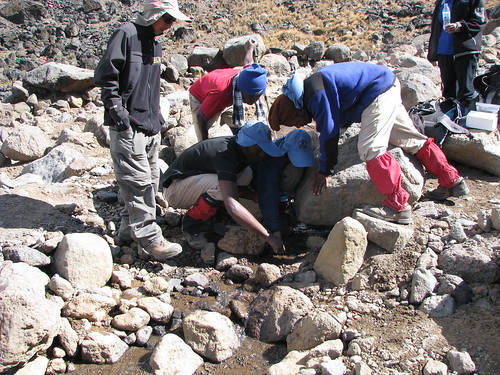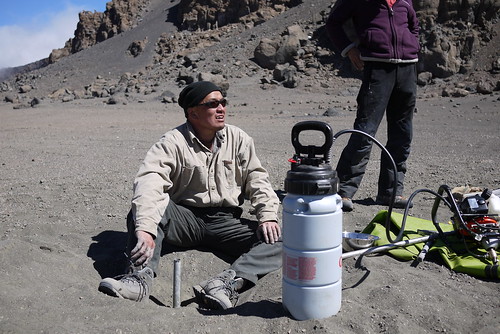Today marks another transition between biomes – from heath zone to alpine desert. An alpine desert is a harsh, dry, windy region that consists of mostly bare rock and ice. Temperatures during the day can soar to 38°C, while at night can be below freezing. The air is very thin, which results in labored breathing as well as more intense solar radiation. The Lava Tower camp sits at approximately 5,029 m (16,499 ft).

Discussing the new biome: alpine desert

Collecting hydrology data in the alpine desert biome

A scientist rests while collecting data
For the remainder of the trip, we will only be posting Maddy and John’s blogs, as Bob will take a different route to the summit. Before Bob left, he wanted to pass along information about his part of the remaining journey:
Tomorrow I will leave the main Xpedition group and go with Kenji, Narita, and Julia (3 of the 4 other scientists) toward the summit via the Western Breech route (1-2 day trip). Once we reach the summit, I will be assisting in a variety of permafrost related activities. It is known that the glacial ice is shrinking and that many people are attributing the shrinking of ice to a changing climate (warmer temperatures and less precipitation). However, another possibility that has not been investigated is that heat flow from magma (located within a few hundred meters of the surface of Kilimanjaro) to the surface may be also contributing to the shrinking glaciers. In order to investigate this possibility, we will be drilling a borehole approximately 6 meters deep, where the glacier has recently retreated, and installing a number of thermistors at various depths. As the glacier shrinks, the thermal properties of the soil change, resulting in the possibility of the re-establishment of permafrost. The mean annual air temperature at the summit is -6oC, meaning that conditions should allow for permafrost development. The borehole will document this newly established permafrost development. Further, we will also carry out a series of measurements on a grid that include the surface temperature, temperature at 40 cm, and the thermal conductivity of the soils. Additionally, we will set up a thermal infrared camera on the crater rim to find hot spots and to measure the surface temperature from the middle of the day through the night (at least midnight) to capture the difference in the amount heat energy that is input and output at the ground surface over the course a day. Finally, we will be downloading temperature data from previous Xpeditions.
Today’s question focuses on the changes between biomes that the team is seeing. The question is: Describe the transition zones as you move from one biome to another. Provide any observations worth noting, such as the atmospheric conditions, flora and fauna.
Maddy
The transition zones between biomes have been very sudden and obvious. There seems to be a new biome every day, and we’re constantly in awe of our changing surroundings. We began in a dry rain forest, where vegetation was bright and colorful, birds were constantly singing and monkeys were present! Within a day found ourselves surrounded by short trees and large rocks in the heath zone(that biome transition was characterized by a sleet storm, in which the entire ground became slick with mud). In the heath zone birds were far less common, and vegetation was more uniform and less exotic. We then moved into moorland, where the birds have been few and far between and vegetation increasingly less colorful (by now we see lots of mellow greens, grays and yellows). I’m currently sitting at lunch in the alpine desert zone… this transition has been the least dramatic thus far. We still see many rocks, and vegetation is similar to that of moorland. Most clouds are now below us, a first since arrival. I’ve spotted three birds, and Julius (our guide) has pointed out buffalo tracks a few times.
John
Seeing the different biomes change from one zone to another is very fascinating. When we reached the end of the rain forest zone the vegetation changes within ten steps on the trail! The tall trees and thick undergrowth vanished and we were left with much shorter plants and what looked to be a much dryer landscape. The heath zone looks much more like a southwest desert area. Where the rain forest was reaching up well over 40 feet in places, the heath zone plants are just tall enough to be overhead. The funny thing is that it has rained more on us while we were in the heath zone than in the rain forest.
Also, where there was an abundance of birds singing in the rain forest, with some large ravens around the camp, the heath zone appears to have less species of birds that are smaller in size. I am looking forward to the changes that the next zones will bring!
